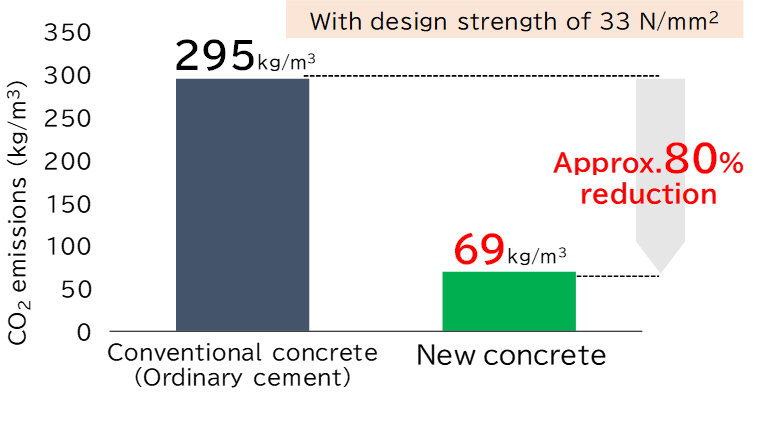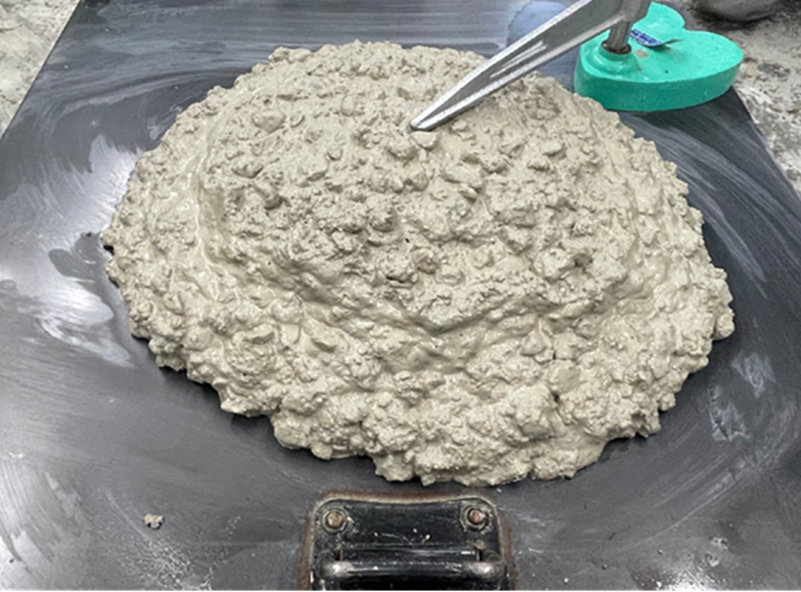MUCC Announces Joint Development of Eco-Friendly Concrete: Blast-Furnace Slag Replaces About 80% of the Cement Material Achieves an 80% Reduction of CO₂ Emissions During the Production Process
Apr 24, 2024
Mitsubishi UBE Cement Corporation (“MUCC”, Head Office: Chiyoda-ku, Tokyo; President: Makoto Koyama) announced today that it has succeeded in developing an eco-friendly concrete with approximately 80% of the cement substituted with blast-furnace slag (BFS), working together with Shimizu Corporation (Head Office: Chuo-ku, Tokyo; President: Kazuyuki Inoue). This concrete utilizes granulated BFS, a byproduct of steel manufacturing processes, as an admixture to achieve an approximately 80% reduction of CO₂ emissions during the production process compared to conventional concrete. Also, in terms of performance, the cement and additive materials have been optimized to deliver excellent thermal cracking resistance.
Advantage #1 of the New Concrete: CO₂ Emissions Reduction
In working to help build a carbon-neutral society, the construction industry is accelerating its efforts to develop technologies for reducing CO₂ emissions derived from concrete, a key building material. Many of these efforts are focused on reducing the use of cement, which is associated with large CO₂ emissions during the production process. Principal alternatives to cement include granulated BFS and fly ash. JIS standards stipulate 70% as the maximum ratio of BFS to be mixed in to blast-furnace cement.1
This new concrete, however, achieves an approximately 80% substitution of granulated BFS for cement by applying basic technologies for realizing low-carbon concrete and cement newly developed by MUCC. While conventional concrete may have CO₂ emissions of 295 kg/m3 during the production process, assuming a concrete design strength of 33 N/mm2 , this new concrete has only around 69 kg/m3 at the same strength, achieving an approximately 80% reduction.
Advantage #2 of the New Concrete: Thermal Cracking Resistance
While concrete incorporating large ratios of BFS is generally able to curb the amount of heat generated, it is also associated with considerable degrees of autogenous shrinkage, which can lead to thermal cracking. This new concrete achieves a drastic reduction of such autogenous shrinkage compared to conventional type-C BFS cement through optimization of the combination of Portland cement and additive materials and adjustment of the concrete formulation. It also maintains levels of fluidity and strength comparable to those of ordinary concrete.

CO₂ Emissions Reduction Achieved by the New Concrete
 Concrete slump test
Concrete slump testThe MUCC mid-term management strategy, “Infinity with Will 2025 — MUCC Sustainable Plan 1st Step,” positions global warming as one of the most pressing issues facing the MUCC Group. Accordingly, the company has formulated an intermediate target for 2030 and a business strategy aimed at achieving carbon neutrality and is working on research and development with the goal of helping to build a carbon-neutral society. This new development of a more eco-friendly concrete is one of MUCC’s efforts to this end. The company remains committed to making technological achievements like this available to a broad range of users, as it moves forward with efforts to contribute to the reduction of environmental impact worldwide.
1 Cement with an admixture of granulated BFS. JIS standards outline the following three classes of BFS cement, according to their BFS content.
Type A: More than 5%, but 30% or less
Type B: More than 30%, but 60% or less
Type C: More than 60%, but 70% or less
For Inquiries Regarding News Releases
Iino Building, 2-1-1 Uchisaiwaicho, Chiyoda-ku, Tokyo 100-8521
Corporate Communications Office, General Affairs Dept.
TEL